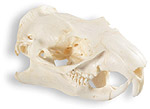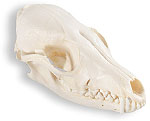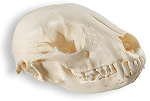Health Care in the Field
|
Three possible reasons for health care in the field.
Since you are the human with the credit card, the cell phone, and the keys to the truck, you are in charge when it comes to emergencies in the field. These emergencies may range from poisoning to traps, from suffocation to laceration.
Whatever the problem, the thing that will matter most in the end is preparation beforehand and quick level-headed action afterward.
Part of preparation is having a decent medical kit with you in the field.
Part of level-headed action is taking the time NOW to think through possible problems and emergencies that might arise.
Field health and emergency situations can be broken down into two categories: critical and chronic.
Chronic Problems:
These are ones that you are most likely to encounter, but that are probably not life-threatening. In all likelihood you will have time to get to the vet if you need to. Examples of chronic problems include:
Basic cuts and lacerations to face and pads from quarry and the hazards of the countryside. After every excursion, look over your dog carefully, especially around the face. Puncture wounds and slashes may not present themselves in an obvious manner, yet any wound not located now is sure to go bad later on. Clean out wounds with clean water (some prefer salt water) and one shot of peroxide followed by a dose of Betadine. Serious rips can be closed with Vetbond or Nexaband, though most facial lacerations will do better if left alone to granulate and close in over time. Really serious wounds, or wounds very near an eye, should be taken to a vet. If you do decide to glue a laceration shut, do not completely close it -- always leave a small "weep" hole for drainage. Put the dog on cephalexin or Clavamox or some other broad-spectrum antibiotic as soon as possible, with a double or "loading" dose at the beginning. If the wound is a puncture, keep it open with a Q-tip and allow it to close from the inside out -- a process that may take a week or two. If the puncture closes at the top, you are likely to get an abscess. For more information on antibiotics for working dogs, see http://www.terrierman.com/antibiotics.htm
Tick, flea and mite infestations. Underground dens can be loaded with seed ticks, fleas and mange mites. Powder or wash your dog after it comes in from the field, and go over it carefully to remove all ticks. A few days later, do this again, as very small ticks that were invisible before are likely to be visible now. See http://www.terrierman.com/fleandtick.htm for maintenance flea-prevention options.
Skunked above ground: The dog may stink, but it will be all right in time as it was not underground. See http://www.terrierman.com/skunk.htm for more information on how to get the stink out of your dog.
Coonhound paralysis: Coonhound paralysis is an auto-immune sickness triggered by the dog's body reacting violently to a protein found in raccoon saliva. Symptoms will show up a few days after you return from the field. The most common reaction is for the dog to get weak in the hind legs and gradually become more paralyzed. The dog may also lose control of its bladder and experience some difficulty breathing. If it's coonhound paralysis, there's not much the vet can do, as antibiotics do not work since there is no pathogen associated with the disease -- it is simply an immune system response to raccoon saliva. Keep your dog bedded down inside with plenty of water, food and rest, and it will probably get better within the month.
Critical Problems:
A dog hit by a car. The best way to avoid this is to not work too close to a road, to only take dogs that have had basic obedience instruction into the field, to never have more than one or two dogs loose at a time, and to put a collar and tag on the dog. This last point is important -- most dogs are hit after they have gotten "lost." Your dog is less likely to get lost and stay lost if you put a metal slide tag on its locator collar.
A dog trapped in a disabling leg hold or body trap. The best way to avoid this is to ask the property owner if anyone has been trapping on his or her property. They may be, and the farmer may have simply forgotten to tell you. A basic leg-hold trap may not do serious injury to a dog -- the trick is to release the dog as quickly and as calmly as possible. This can be done by stepping on the leaf spring to the left or right of the trap. Some traps have two leaf-springs - most have just one. To read more about releasing a dog from a trap, especially the very difficult to release Conibear trap, see www.terrierman.com/traprelease.htm
Heat stroke: A dog that gets over-heated will tend to lie down, but some get so adrenalized while hunting, that they push themselves over the edge. A good soaking will bring the dog's temperature down, as will time spent under the car or truck, or better yet inside a crate in an air-conditioned vehicle. Give the dog water, but don't let it drink forever -- a very hot dog can start to drink water in an almost maniacal fashion, creating a toxic effect as their electrolytes get out of balance. A dog that is drinking water very fast should have the water taken away for 10 minutes, and then given another opportunity to fill up after it has calmed down a bit.
Hypothermia: A dog can work fine below ground, but quickly succumb from hypothermia when it gets above ground on a really cold, windy day. Small dogs have finite energy reserves. A dog that bays for an hour or more underground will come out of the ground exhausted and breathing hard. As the adrenaline in its systems falls, and cold air is sucked into its lungs, the dog's core body temperature may fall rapidly. If your dog looks like he or she is in trouble, tuck it inside your coat and get back to the truck or car as quickly as possible. Wrap your dog in a space blanket if you have one (see first aid kit suggestions, below) and crate it with a well-taped solid-fuel hand warmer if you have one.
A dog suffocated underground: The bigger the dog and the smaller the hole, the more likely you are to have problems in this arena. A small dog can scoot over dirt, but a big dog will push it behind him, and a groundhog can easily "seal the bottle" by putting up a wall of dirt in front of the dog. Another problem can occur if your dog sticks his head into a small hole made by a posthole digger. If the dog latches on to the quarry in such a situation, it may find its nose pressed tight into the hole and the dog may pass out from lack of oxygen before it is able to relax its grip. If your dog passes out, remember that doggie CPR is a lot like human CPR. As quickly as possible put the dog on its back. Holding the dog's snout like a beer can, put your entire mouth over its nose and take a small puff into the dog's lungs. One breath every 5 seconds should be about right for a working terrier. If this does not revive your dog after 15 seconds, massage the dog's chest as you would a human's, and then repeat mouth-to-snout resuscitation.
A dog skunked underground. The trick here is getting the dog out of the ground as fast as possible. Even if the dog is fine when it comes out of the ground, your problems may not be over. A dog skunked underground can be a serious situation. For more information, see: http://www.terrierman.com/skunk.htm
Ingestion of poison. If your dog ingests a rodent bait block (or even if it might have), pour a shot or two of hydrogen peroxide down the dog to get it to throw up. Rodent bait is often bright blue or bright orange. Get the dog to a vet as quickly as possible, as coagulating agents can help offset wafarin. If the poison is anti-freeze (ethylene glycol -- a greenish colored liquid often found in parking lots), get the dog to a vet as soon as possible and pray. A huge tube-fed dose of activated carbon may bring the dog through if it is started soon enough.
Snakebite. Most snakes are not poisonous, but if your dog is bit by a rattlesnake or water moccasin, it is in serious trouble. A working terrier is a small animal and a snake will generally have hit your dog hard several times during the attack. Get the dog to a vet as quickly as possible and pray
In the field, I carry:
|
A
Complete Vet Kit for the Truck or Car My vet kit is in a bright orange plastic tool box that I picked up at Home Depot. The box contains the following items: |
How to Apply Vetbond or Nexaband Basically, this is superglue for dogs. Though superglue can work for small cuts, Vetbond and Nexaband (a competitor that does the same thing) are about 4 times stronger, last longer, and are more flexible. In addition, they do not have any toxic formaldehyde residues. Either product can be used, and should be put on in drops to close a wound. It will slough off after about 7 days -- reapply after 5 days for more serious wounds. Compared with a traditional suture, the new veterinary superglue has several advantages. One average, is that it takes only one-tenth of the time to close an incision. The bonding strength is equal to a 5-0 monofilament suture. It also has an anti-microbial effect that can decrease infection rates in contaminated wounds. The cosmetic appearance of the healed incision is also better than with a suture, though in the case of most facial lacerations, there is no need to close the wound at all -- simply allow it to granulate in, and the dog's facial features will remain undistorted. To use Vetbond
or Nexaband, make sure the wound edges are
straight and lie together naturally. Hold gauze
against the area immediately below the cut in
order to catch any drips as you apply the glue.
Apply tiny dots of glue sparingly at intervals
where the wound edges meet. Thick applications
tend to crack and loosen prematurely. It;s a bit
like spot-welding. |

A good vet is loved by all.


